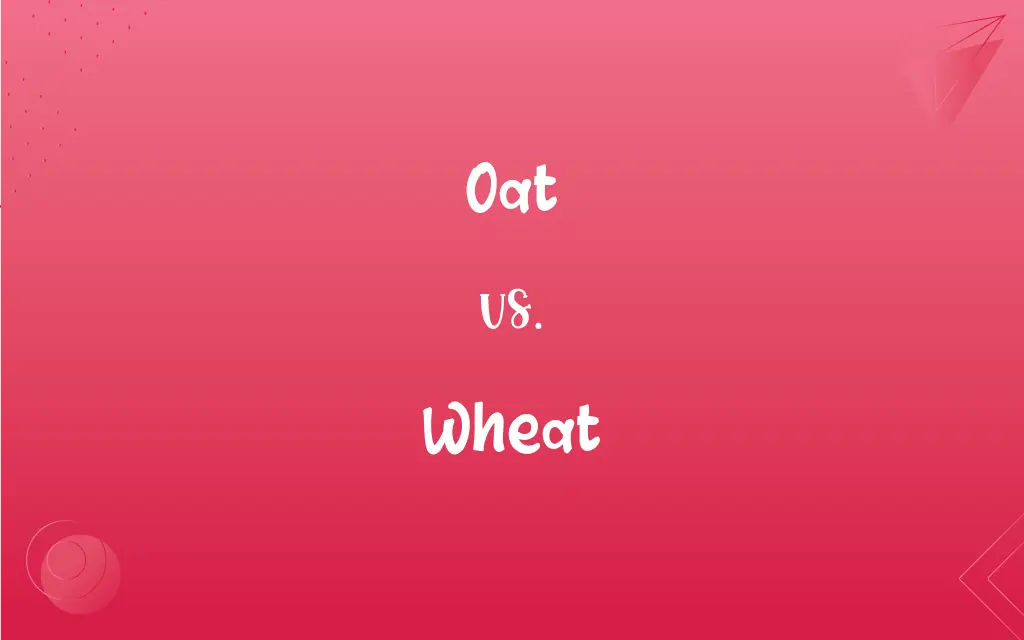Oat vs. Wheat: What's the Difference?
Edited by Janet White || By Harlon Moss || Updated on October 5, 2023
Oats are grains from the cereal plant Avena sativa, commonly eaten in the form of oatmeal, while wheat, derived from various Triticum species, is a staple grain used globally, often milled into flour.

Key Differences
Oats, derived from the Avena sativa plant, stand distinct in their use and nutritional content compared to wheat. Principally, oats are recognized for their fibrous content and are often consumed as a breakfast cereal (oatmeal) or used in baking. On the other hand, wheat, which is procured from various species under the genus Triticum, emerges as a primary grain in numerous diets worldwide, boasting extensive use in bread, pasta, and numerous baked goods.
Nutritionally, oats are often lauded for their rich fiber content, particularly beta-glucans, which are known to benefit heart health. These grains typically have a creamy texture when cooked and are prevalent in a variety of dishes like porridge, granola, and certain baked goods. Conversely, wheat, while also a source of dietary fiber, predominantly makes its nutritional mark with its protein content and is frequently transformed into flour, becoming a foundational ingredient in an expansive array of culinary creations globally.
In the context of agricultural production, oats tend to be hearty grains, capable of thriving in less-than-ideal conditions, such as low soil fertility and suboptimal weather conditions. The adaptability of oats often allows them to be grown in regions where wheat might struggle. In a similar vein, wheat, while showcasing some level of resilience, generally requires more specific conditions for optimal growth and is extensively cultivated worldwide, sometimes demanding more meticulous care in terms of soil quality and weather conditions compared to oats.
From a culinary perspective, oats offer a moist, chewy texture to dishes and are often utilized in sweets and snacks, aside from their renowned role in breakfast dishes. Wheat, with its vast range of applications, spans from the production of various types of flours, serving as a base for multiple products, to direct consumption in certain whole or cracked forms, thereby displaying a wide-reaching culinary versatility that significantly surpasses that of oats.
On a commercial scale, oats are predominantly marketed for their health benefits and are thus a popular choice amongst health-conscious consumers. In contrast, wheat tends to be commodified in various forms, from whole wheat grains to numerous types of flours, thereby slotting itself as a staple, must-have item in kitchens and commercial food production entities across the globe.
ADVERTISEMENT
Comparison Chart
Primary Usage
Often consumed as oatmeal
Frequently milled into flour
Nutritional Focus
Noted for its high fiber content
Known for its protein content
Agricultural Demand
Can grow in suboptimal conditions
Generally requires more specific conditions
Culinary Application
Predominantly in breakfast and snacks
Extensive, from bread to pasta
Commercial Aspect
Marketed for health benefits
Commodified in various forms globally
ADVERTISEMENT
Oat and Wheat Definitions
Oat
A hearty grain able to grow in challenging conditions.
Despite the poor soil, the oat crop thrived.
Wheat
A cereal plant that is globally used in various culinary forms.
Wheat is a fundamental ingredient in bread-making.
Oat
A grain known for its high fiber content.
Adding oat to your diet can aid digestion.
Wheat
Cultivated worldwide and used in numerous cuisines.
Wheat production plays a vital role in global agriculture.
Oat
A common ingredient in breakfast foods.
She made a bowl of oat porridge for breakfast.
Wheat
Present in various forms, from whole grains to refined flour.
From cereals to pasta, wheat finds its way into numerous dishes.
Oat
A cereal grain derived from the Avena sativa plant.
The oat fields stretched far into the horizon.
Wheat
A significant source of dietary protein.
Consuming wheat can contribute to your daily protein intake.
Oat
Often utilized in baking and snack production.
The oat cookies were delightfully chewy and sweet.
Wheat
A grain often milled to produce flour.
The wheat flour was used to bake a loaf of bread.
Oat
Any of various grasses of the genus Avena, especially A. sativa, widely cultivated for their edible grains.
Wheat
Any of various annual cereal grasses of the genus Triticum of the Mediterranean region and southwest Asia, especially T. aestivum, widely cultivated in temperate regions in many varieties for its commercially important edible grain.
Oat
The grain of any of these plants, used as food and fodder.
Wheat
The grain of any of these grasses, ground to produce flour used in breads, pasta, and other foods.
Oat
A musical pipe made of an oat straw.
Wheat
(countable) Any of several cereal grains, of the genus Triticum, that yields flour as used in bakery.
FAQs
Are oat and wheat considered healthy grains?
Yes, both are valued for their nutritional content, with oat being recognized for fiber and wheat for protein.
Can oat and wheat be used interchangeably in recipes?
Not always, as their distinct textures and nutritional profiles can alter the outcome of a dish.
What types of wheat flour are commonly available?
Varieties like all-purpose, whole wheat, and bread flour are some commonly available wheat flours.
What are the different forms in which oat is available?
Oat is available in several forms like steel-cut, rolled, and quick oats, each differing in processing and cooking times.
In which dishes is wheat predominantly found?
Wheat is pervasive in a variety of foods, including bread, pasta, cereals, and numerous baked goods.
Can people with gluten sensitivity consume oats without issues?
Oats are naturally gluten-free but can be cross-contaminated; thus, ensuring they are certified gluten-free is crucial.
Which is generally considered better for heart health?
Oat often gains spotlight for heart health due to its beta-glucan fiber, which can lower cholesterol levels.
Which of oat or wheat generally requires more careful growing conditions?
Wheat typically demands more specific growing conditions compared to the more hardy oat.
Which grain is typically more prevalent in gluten-free diets?
Oat is often found in gluten-free diets, although ensuring they are not cross-contaminated is crucial.
Is oatmeal made from whole oat grains?
Oatmeal is generally made from rolled oats, which are whole oats that have been steamed and flattened.
How does the protein content compare between oat and wheat?
Generally, wheat tends to have higher protein content compared to oat, making it vital in many diets.
Which grain, oat or wheat, is more likely to be found in cereals?
Both grains are common in cereals, but wheat is often more prevalent in various forms and types.
What distinguishes steel-cut oats from rolled oats?
Steel-cut oats are chopped whole oats and retain a chewy texture, while rolled oats are steamed and flattened, cooking faster.
Are there any whole grain versions of wheat available in the market?
Yes, whole grain wheat is widely available, often as whole wheat flour or as whole wheat berries.
How does the fiber content of oat and wheat compare?
Oats generally provide more fiber, especially soluble fiber, which can assist in regulating blood sugar and cholesterol.
What’s a common product made from wheat, often used in daily meals?
Bread is a widespread product made from wheat, integral to many global cuisines and meals.
Are there gluten-free varieties of wheat available?
While wheat inherently contains gluten, there are genetically modified versions, like einkorn, which contain less gluten.
What is oat commonly used for in culinary contexts?
Oat is frequently utilized in breakfast foods, baking, and snack items due to its hearty and chewy texture.
Which of the two grains - oat or wheat - is more widely cultivated globally?
Wheat tends to have a broader global cultivation due to its extensive use in a myriad of culinary applications.
Is oat flour suitable for bread-making like wheat flour?
Oat flour can be used in bread-making but often needs to be mixed with other flours as it lacks gluten.
About Author
Written by
Harlon MossHarlon is a seasoned quality moderator and accomplished content writer for Difference Wiki. An alumnus of the prestigious University of California, he earned his degree in Computer Science. Leveraging his academic background, Harlon brings a meticulous and informed perspective to his work, ensuring content accuracy and excellence.
Edited by
Janet WhiteJanet White has been an esteemed writer and blogger for Difference Wiki. Holding a Master's degree in Science and Medical Journalism from the prestigious Boston University, she has consistently demonstrated her expertise and passion for her field. When she's not immersed in her work, Janet relishes her time exercising, delving into a good book, and cherishing moments with friends and family.































































